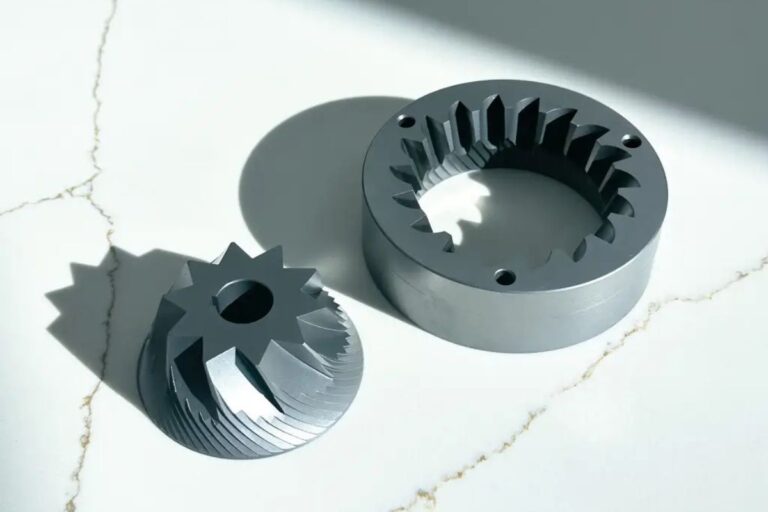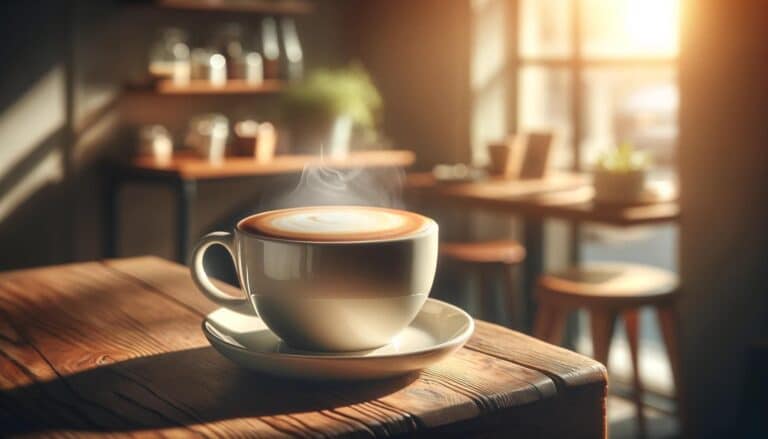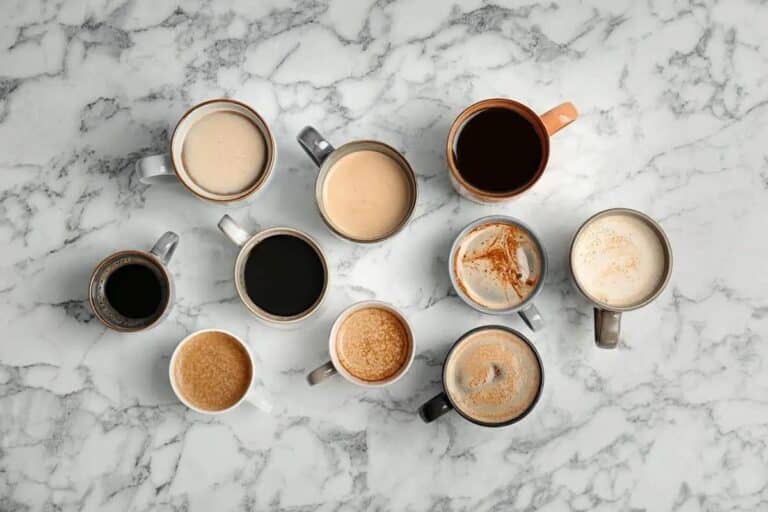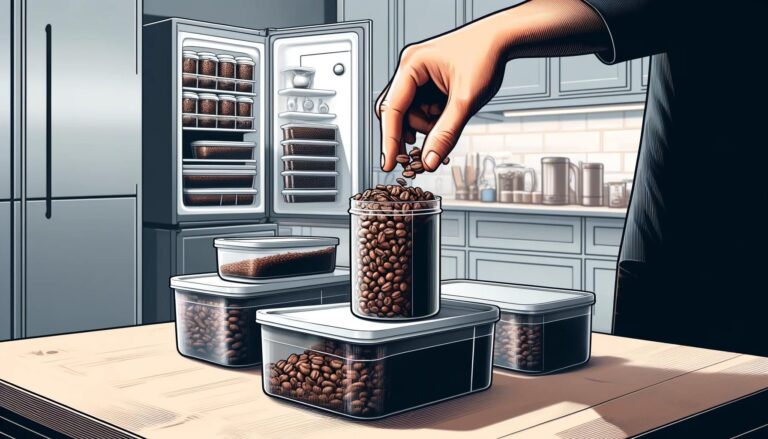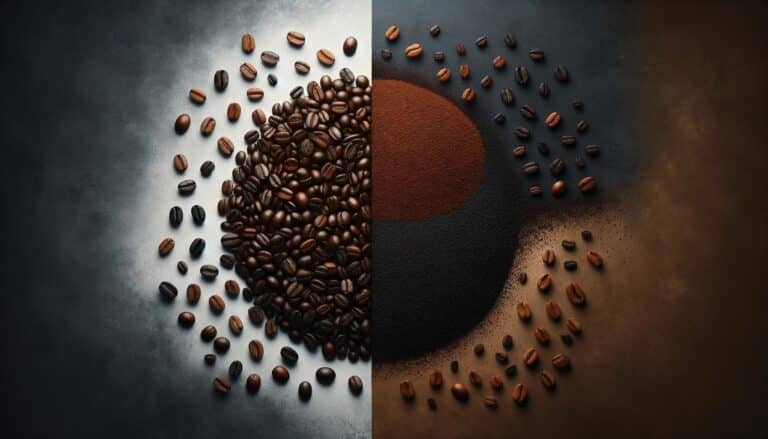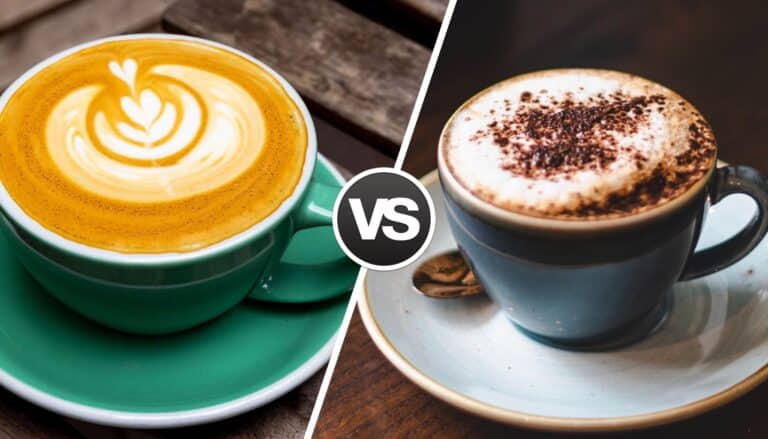Grab a cozy spot and get ready to dive into the wonderful world of coffee and espresso, two delicious drinks that have won over millions of hearts worldwide. Each has a special allure and taste that have charmed generation after generation. Their impact isn’t just in our mugs, though – they’ve shaped cultures, ignited conversations, and even propelled economies. Yet, despite their wide popularity, distinguishing between the two can sometimes feel like a riddle. Let’s unravel this mystery and explore the contrasts and commonalities of coffee and espresso. We’ll journey through their origins, brewing techniques, taste notes, caffeine levels, and the elements that bring their distinct flavors to life. As we deepen our understanding, we’ll unlock the subtleties and craftsmanship in each cup, and who knows? You might just discover your new go-to brew!
Understanding Coffee
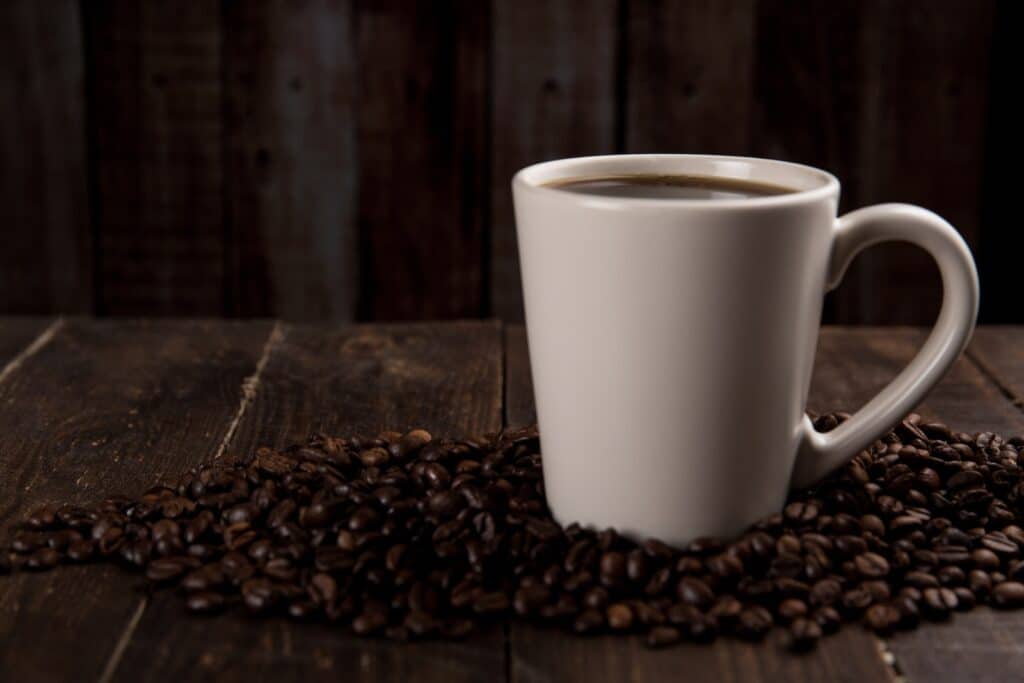
Definition of Coffee
Coffee is a globally celebrated beverage made from the roasted seeds, often referred to as ‘beans,’ of the Coffea plant. The drink is believed to have originated in Ethiopia as early as the 9th century. There are records of it being cultivated and consumed in the Arabian Peninsula by the 15th century. Coffee’s stimulating effects, rich flavors, and social connotations quickly led to its spread across the world, transforming it into the ubiquitous beverage we recognize today.
How is Coffee Made?
There are several brewing methods for coffee, each producing a distinct taste and strength. Some of the most common include:
- Drip Coffee or Filter Coffee: This is the most popular method in many households and workplaces. Hot water is poured over medium-to-coarse ground coffee in a filter, allowing it to ‘drip’ into a container below.
- French Press or Plunger Coffee: This method involves steeping coarse coffee grounds in hot water for several minutes before a mesh plunger is pressed down to separate the coffee liquid from the grounds.
- Cold Brew: A process in which coffee grounds are steeped in cold water for an extended period, usually 12-24 hours. This slow extraction method results in a smooth, less acidic coffee concentrate that can be diluted with water or milk.
Taste, Aroma, and Caffeine Content in Coffee
The tantalizing taste and aroma of coffee can shift dramatically based on a variety of elements. Things like the type of coffee bean, its home soil, the roast it receives, and the brewing process can all play a part. Coffee generally presents a complex harmony of sweetness, bitterness, acidity, and aroma. Think of it as a symphony of flavors, with notes of chocolate, fruit, nuts, and spices playing out on your palate.
Now, let’s talk about the caffeine kick. A standard 8-ounce cup of coffee usually packs around 95 milligrams of caffeine. However, this can swing between 70 and 140 milligrams, influenced by factors like the coffee bean type and brewing technique. Here’s an interesting coffee fact – even though espresso is more concentrated, a cup of coffee tends to deliver more caffeine in total, thanks to its larger serving size.
Understanding Espresso
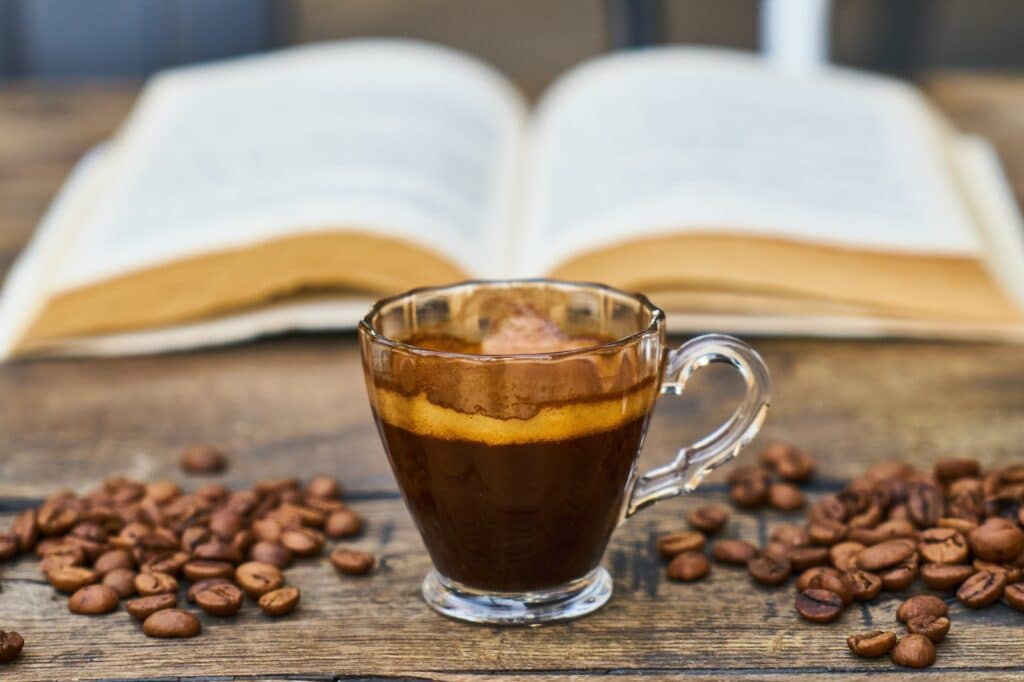 Teacup With Espresso Beverage” class=”wp-image-830″/>
Teacup With Espresso Beverage” class=”wp-image-830″/>Definition of Espresso
Espresso is a concentrated form of coffee served in small, strong shots and is the base for many coffee shop favorites like lattes, cappuccinos, and Americanos. Espresso originated in Italy in the late 19th century. This resulted from the invention of the espresso machine that could brew coffee using high pressure. The word ‘espresso’ itself is derived from the Italian verb ‘esprimere’ meaning ‘to express’ or ‘to press out,’ referring to the way the coffee is made.
How is Espresso Made?
The process of making espresso is both an art and a science. Unlike other coffee brewing methods, making espresso requires specialized equipment—an espresso machine. The coffee beans are ground very finely, much finer than for drip coffee, and packed into a ‘portafilter.’ High-pressure hot water is then forced through the tightly packed grounds. This process should take between 20-30 seconds and results in a thicker, concentrated shot of coffee topped with a layer of crema— a golden, aromatic froth made up of oils, proteins, and sugars from the coffee beans.
Taste, Aroma, and Caffeine Content in Espresso
Espresso has a stronger, more concentrated flavor than regular coffee. It is often described as bold and full-bodied. It may also have a higher level of acidity, which can add a distinct brightness to the taste. The crema on top of a shot of espresso also adds to the richness of the flavor and texture.
Espresso’s aroma can vary significantly depending on the beans used, but it generally has a strong, roasted scent that can have hints of caramel, nuts, or even fruit.
When it comes to caffeine content, an average shot of espresso (about 1 ounce) contains roughly 63 milligrams of caffeine. However, due to its smaller serving size, a typical espresso shot has less total caffeine than a standard cup of coffee. It’s the concentrated nature of espresso that often leads to the misconception that it contains more caffeine than other coffee drinks.
The Differences Between Espresso and Coffee
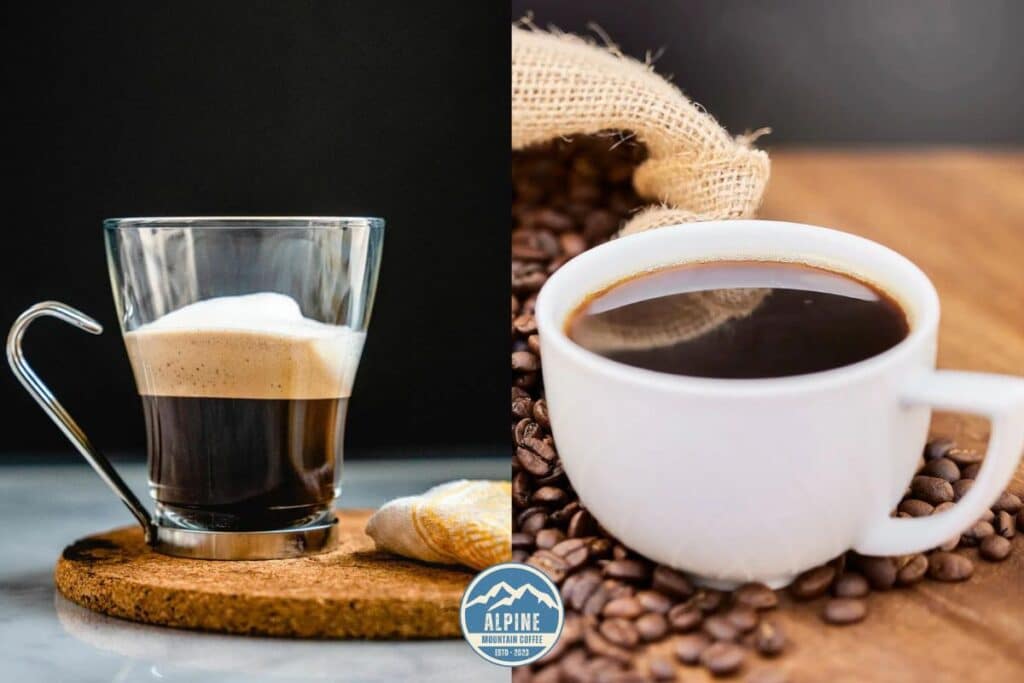
Brewing Methods
The key difference between brewing espresso and coffee lies in the brewing process. Making coffee generally involves pouring hot water over coffee grounds and allowing the mixture to steep or drip. The water is usually in contact with the coffee grounds for a few minutes, which results in a relatively diluted drink.
On the other hand, brewing espresso requires forcing hot water under high pressure through finely-ground coffee. This process occurs in a matter of seconds and yields a more concentrated beverage with a unique body and texture, often topped with a layer of crema.
Taste and Aroma
While both coffee and espresso are derived from the same beans, the differences in brewing methods result in distinct tastes and aromas. A cup of coffee offers a milder flavor compared to an espresso shot, which has a bold, robust, and concentrated taste. The aroma of coffee can be described as somewhat delicate with varying notes depending on the type of bean and roast, while espresso’s aroma is typically more potent and intense.
Caffeine Content
Contrary to popular belief, espresso does not contain more caffeine than coffee. While espresso is more concentrated, containing around 63 milligrams of caffeine per 1-ounce shot, a standard 8-ounce cup of coffee contains around 95 milligrams of caffeine. Therefore, in terms of total caffeine content, coffee usually delivers more. However, if you were to measure caffeine concentration per ounce, then espresso would indeed be stronger.
Serving Size and Common Drink Derivatives
Espresso and coffee also differ significantly in serving size and the range of derivatives they form. Espresso is typically served in small quantities, usually a 1-ounce shot, and forms the basis for other drinks like lattes, cappuccinos, macchiatos, and Americanos.
In contrast, coffee is usually served in larger cups or mugs. It can be enjoyed black, or with added milk, cream, sugar, or flavored syrups. There are also various styles of brewed coffee like iced coffee, cold brew, and the strong Turkish coffee.
Factors Influencing the Taste of Coffee and Espresso

Coffee Bean: Arabica vs. Robusta
Coffee beans play a significant role in the flavor of both coffee and espresso. The two main types of coffee beans are Arabica and Robusta, each offering distinct taste profiles. Arabica beans are generally more expensive, sweeter, and have a softer, more complex flavor with notes of sugar, fruit, and berries. Robusta, on the other hand, has a stronger, harsher taste, with a nutty, chocolatey aftertaste and twice as much caffeine as Arabica. A blend of both is often used in espresso to achieve a balance of flavor, acidity, and crema.
How Grind Size Affects Flavor
Grind size is a crucial factor that affects the flavor extraction in both coffee and espresso. For regular coffee, a medium to coarse grind is typically used to ensure the water filters through at the right speed, extracting a balanced flavor. Espresso, on the other hand, requires a fine grind to withstand the pressure of the espresso machine and to slow down the water flow for optimal extraction, resulting in a richer, fuller-bodied taste.
Water Quality and Temperature
Water makes up about 98% of a cup of coffee or espresso, so its quality and temperature can significantly affect the final taste. Water that is too hard or too soft can influence how the flavors are extracted from the coffee grounds, possibly leading to a flat or over-extracted taste. The ideal brewing temperature for both espresso and coffee is typically around 195°F to 205°F. Too hot, and the coffee may taste burnt or overly bitter; too cool, and the flavors may not fully extract, resulting in a weak, underdeveloped taste.
Effect of Pressure in Espresso Making
Pressure is a unique factor that distinguishes espresso from other types of coffee. Espresso is brewed using high pressure (usually 9 bar), which forces hot water through the finely ground coffee quickly. This rapid extraction process results in a concentrated, richly flavored beverage with a distinctive body and a layer of crema on top. The pressure must be carefully calibrated; too much can over-extract the coffee and make it bitter, while too little can under-extract it, leading to a sour, weak espresso.
Choosing Between Coffee and Espresso

Choosing between coffee and espresso ultimately comes down to individual preference in taste and strength. If you enjoy a milder, larger volume drink that you can sip slowly, then coffee might be your go-to choice. However, if you prefer a smaller, more concentrated, and robust shot of caffeine, then espresso would be the better fit. Keep in mind that both coffee and espresso can have a wide range of flavor profiles depending on the beans and brewing methods used.
The equipment and time needed to brew coffee and espresso are quite different. Brewing coffee can be as simple as using a manual drip cone and hot water, to more complex methods like using a French press or a cold brew setup. Generally, these methods require minimal equipment and can be done at home with relative ease.
On the other hand, making espresso typically requires an espresso machine, which can be a significant investment. These machines also require regular cleaning and maintenance. The process of making an espresso shot – grinding the beans, tamping the coffee, pulling the shot – is more involved and time-consuming than most coffee brewing methods.
Cultural traditions can also play a role in whether coffee or espresso is preferred. For example, in Italy, espresso is deeply ingrained in daily life, often consumed quickly at the bar of a café during various times of the day. On the other hand, in the United States, coffee – especially drip coffee – is a staple, often enjoyed in larger volumes and sipped slowly throughout the morning. In recent years, specialty coffee culture has broadened the tastes and preferences of people worldwide, introducing more individuals to a wider range of coffee and espresso drinks.
Conclusion
While espresso and coffee are both derived from the same raw material – the coffee bean – their differences are distinct and noteworthy. These differences lie mainly in the brewing process, taste, and concentration. Espresso is brewed under high pressure, resulting in a small, concentrated shot with a rich and robust flavor. Coffee, in contrast, is typically brewed with a drip or immersion method, resulting in a larger, less concentrated drink with a milder flavor.
The caffeine content in each also varies, with a typical cup of coffee usually containing more total caffeine than a shot of espresso due to the larger serving size. However, when compared ounce for ounce, espresso is more concentrated and therefore contains more caffeine.
Regardless of the differences, both espresso and coffee hold a cherished place in global culture, each with its unique rituals and traditions. They both have the power to energize, comfort, and bring people together, and are an essential part of the day for many people worldwide.
The choice between coffee and espresso often comes down to personal preference, lifestyle, and sometimes cultural background. Some may favor the quick, intense kick of an espresso, while others may prefer the slower, more prolonged experience of sipping a cup of coffee. Regardless of the choice, it’s clear that both beverages, in their myriad forms, continue to captivate and caffeinate the world. As you explore the wide world of coffee, may each cup, or shot, be a delightful experience.
References
- National Coffee Association USA. (n.d.). Coffee and its history. https://www.ncausa.org/About-Coffee/History-of-Coffee
- Illy, A., & Viani, R. (2005). Espresso Coffee: The Science of Quality. Elsevier.
- Mayo Clinic. (n.d.). Caffeine Content for Coffee, Tea, Soda and More. https://www.mayoclinic.org/healthy-lifestyle/nutrition-and-healthy-eating/in-depth/caffeine/art-20049372
- Hoffmann, J. (2018). The World Atlas of Coffee: From Beans to Brewing. Octopus Publishing Group.
- (2017). Effect of Different Brewing Methods on Antioxidant Capacity and Phenolic Composition of Coffee. LWT – Food Science and Technology, 75, 1-7.
- (2020). The physics of pulling espresso shots. Physics Today, 73(4).
- Colonna-Dashwood, M. (2017). The Coffee Dictionary: An A-Z of coffee, from growing & roasting to brewing & tasting. Chronicle Books.
